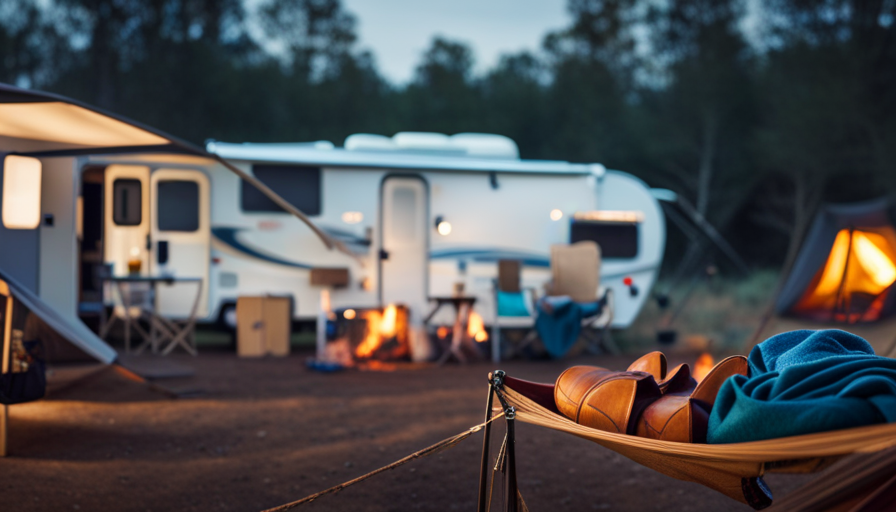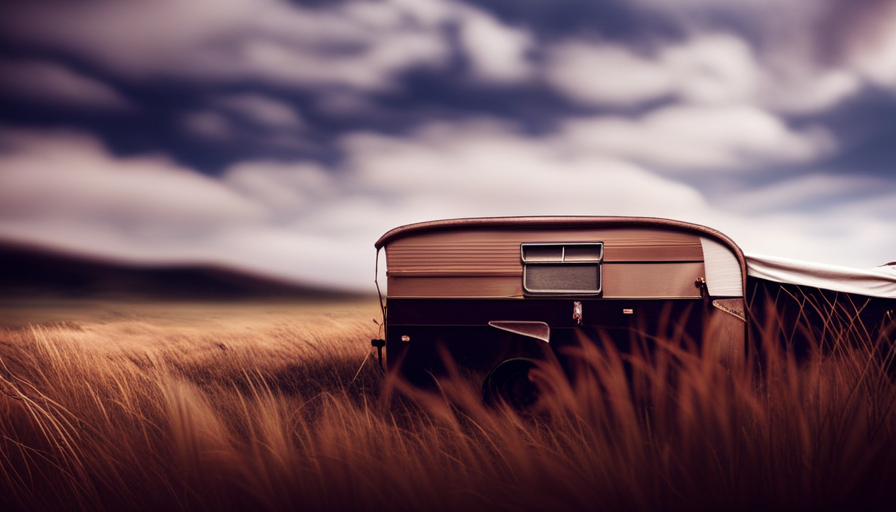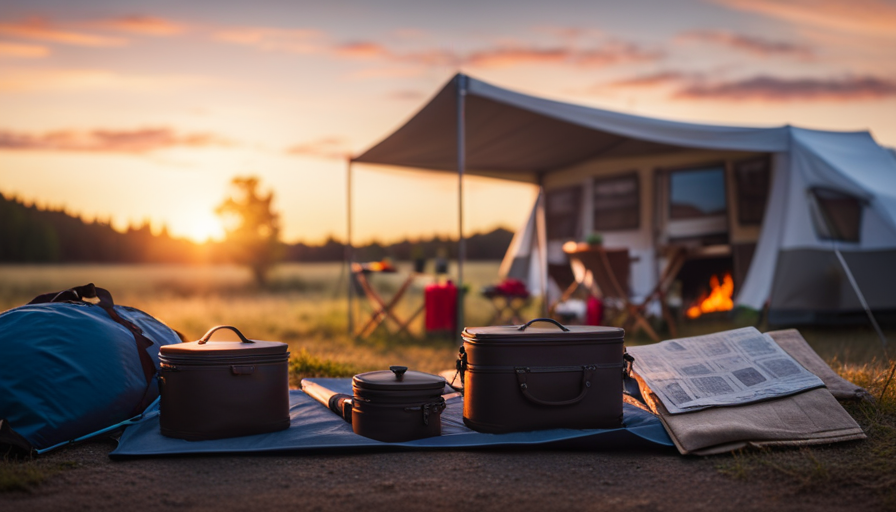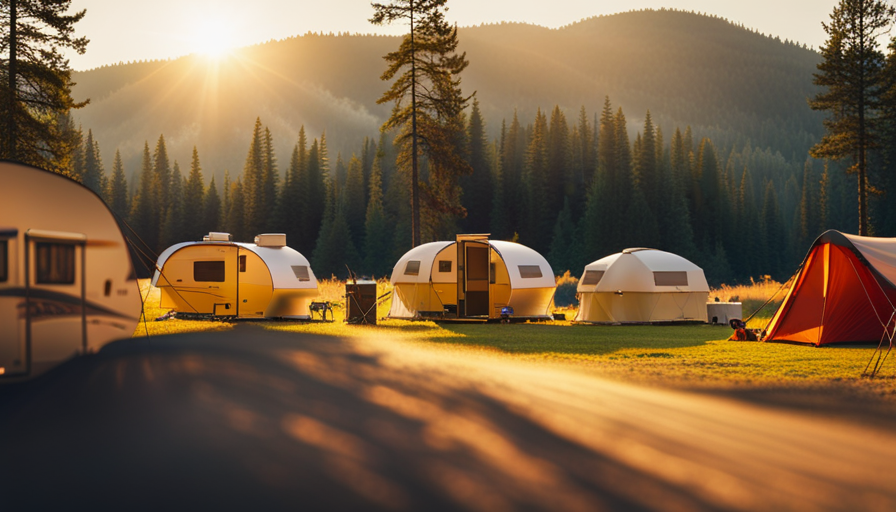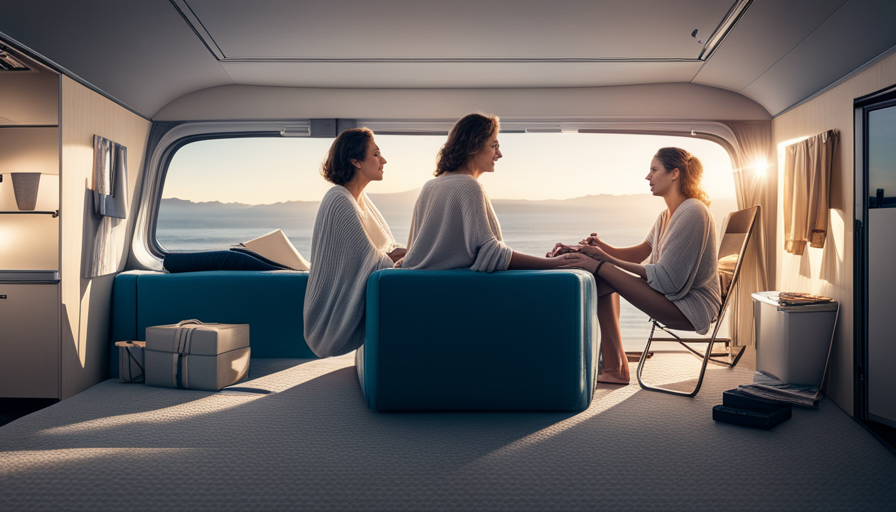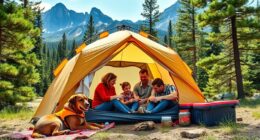Prepping your gear for a camping trip can stir up feelings of excitement and overwhelm. However, don’t worry, fellow camping enthusiasts! We’re here to assist you in maneuvering through the complexities of packing with our thorough and useful guide. So, gather your equipment and let’s start this journey together!
Kitchen supplies are a crucial component of any camper’s arsenal. From pots and pans to utensils and plates, we’ve got you covered. And don’t forget the all-important coffee maker to kickstart your mornings in the great outdoors.
Next up, bedding. A cozy and comfortable sleep is essential after a day exploring nature’s wonders. Pack your pillows, blankets, and sleeping bags for a restful night under the stars.
Outdoor gear is a camper’s best friend. From hiking boots to fishing rods, make sure you have the essentials for all your outdoor activities. And don’t forget the bug spray and sunscreen to protect yourself from nature’s little annoyances.
Clothing and personal items should be chosen wisely. Pack versatile and weather-appropriate clothing, as well as toiletries to keep you fresh and clean.
Lastly, tools and equipment are a camper’s lifeline. A multitool, duct tape, and a flashlight are just a few of the handy items to have on hand for any unexpected situations.
With our comprehensive packing list, you’ll be ready to hit the road and embrace the freedom of the open road. So, let’s get packing, adventurers! The great outdoors awaits!
Key Takeaways
- Kitchen supplies such as pots, pans, utensils, and plates are crucial for any camper.
- Bedding, including pillows, blankets, and sleeping bags, is essential for a comfortable sleep.
- Outdoor gear like camping chairs, tables, lanterns, and flashlights are important for outdoor activities.
- Efficient clothing storage using collapsible storage bins or vacuum-sealed bags can save space in a camper.
Kitchen Supplies
Don’t forget to pack all the kitchen supplies you’ll need in your camper! Proper kitchen organization is essential for an enjoyable camping experience. Start by making a checklist of all the necessary items. This will help you stay organized and ensure that you don’t forget anything important.
When it comes to meal planning, think about the types of meals you’ll be preparing and the equipment you’ll need. Basic kitchen supplies such as pots, pans, utensils, and knives should be at the top of your list. Don’t forget to pack a cutting board, can opener, and measuring cups and spoons. It’s also a good idea to bring along some storage containers for leftovers and snacks.
To maximize space, consider using collapsible or nesting cookware. This will help keep your kitchen area tidy and save you valuable storage space.
With your kitchen supplies packed and organized, you can now move on to the next section about bedding.
Bedding
When it comes to bedding essentials for our camper, we always make sure to pack sleeping bags or blankets to ensure a comfortable night’s sleep.
Pillows and pillowcases are also a must-have, as they provide extra support and a touch of home.
In addition, we bring along sheets or sleeping bag liners to add an extra layer of comfort and cleanliness to our sleeping arrangements.
Sleeping bags or blankets
Make sure you pack your sleeping bags or blankets to stay warm and comfortable during your camping trip. Here are three things to consider when choosing the right bedding for your camper:
-
Sleeping bag vs. air mattress: Decide whether you prefer the cozy, cocoon-like feeling of a sleeping bag or the cushioned support of an air mattress. Consider factors such as space, ease of setup, and personal preference.
-
Insulation and temperature rating: Look for sleeping bags or blankets that offer adequate insulation for the climate you’ll be camping in. Check the temperature rating to ensure it’ll keep you warm during chilly nights.
-
Size and storage: Consider the size and weight of your sleeping bags or blankets, especially if you have limited space in your camper. Opt for compact options that can easily be stored when not in use.
Now that you’ve got your bedding sorted, let’s move on to pillows and pillowcases.
Pillows and pillowcases
Rest your weary head on a plush pillow and dream of peaceful nights under the stars. When packing for a camper trip, pillows and pillowcases are essential for a good night’s sleep.
There are a few options to consider when it comes to pillow stuffing. Down pillows are soft and provide excellent support, but they can be expensive. Synthetic pillows are a more affordable alternative and are hypoallergenic, making them suitable for those with allergies. Memory foam pillows are another popular choice as they contour to the shape of your head and neck, providing optimal comfort.
Whichever option you choose, make sure to pack enough pillowcases to keep them clean and fresh.
Now that we have our pillows sorted, let’s move on to the next item on our packing list: sheets or sleeping bag liners.
Sheets or sleeping bag liners
Don’t forget to bring along sheets or sleeping bag liners to ensure a cozy and comfortable night’s sleep in the great outdoors. While sleeping bags are a popular choice for camping, using liners or sheets can provide some great benefits.
Sleeping bag liners are lightweight and compact, making them easy to pack and transport. They also add an extra layer of warmth, especially in cooler temperatures.
Sheets, on the other hand, offer a more familiar feel and can be easily washed after use. Another advantage of using liners or sheets is that they can help protect your sleeping bag from dirt, sweat, and other elements.
So whether you prefer the convenience of a liner or the comfort of sheets, both options are great sleeping bag alternatives that will enhance your camping experience.
Now let’s move on to the next section about outdoor gear.
Outdoor Gear
When it comes to outdoor gear, there are a few key items that are essential for a successful camping trip. First and foremost, camping chairs and tables are a must-have for comfortable seating and dining options.
Lanterns or flashlights are also crucial for providing adequate lighting during the evenings.
Lastly, a portable grill or stove is essential for cooking delicious meals while enjoying the great outdoors. These items not only enhance the camping experience but also provide convenience and practicality.
Camping chairs and tables
Grab your trusty camping chairs and tables, the backbone of your outdoor oasis, and let them transport you to a serene campsite by the glistening lake.
When it comes to camping chair maintenance, it’s important to keep them clean and dry. Before storing them, wipe off any dirt or moisture, and make sure they are completely dry to prevent mold or mildew.
As for choosing the right camping table, consider the size and weight. A lightweight, foldable table is ideal for easy transportation and setup. Look for one with adjustable legs for uneven ground.
Now, let’s shed some light on the next essential item for your camper: lanterns or flashlights. These will keep the darkness at bay and guide you through your camping adventures.
Lanterns or flashlights
Illuminate your outdoor escapades with the warm glow of lanterns or flashlights, essential tools that will guide you through the darkness of the wilderness. When it comes to lighting up your campsite, you have two main options: lanterns or flashlights.
While flashlights are compact and easy to carry, lanterns offer several advantages that make them a better choice. Lanterns provide a wider and more even spread of light, illuminating a larger area and making it easier to navigate around your campsite. They also often have adjustable brightness settings, allowing you to customize the level of light based on your needs. Additionally, lanterns can be hung from trees or hooks, freeing up your hands and providing overhead illumination.
So, make sure to pack a reliable lantern to enhance your camping experience. Speaking of enhancing, let’s move on to the next section about portable grill or stove.
Portable grill or stove
Make your camping experience sizzle with a portable grill or stove, a must-have tool for cooking up mouthwatering meals under the open sky. Whether you prefer the smoky flavor of grilled burgers or the convenience of a quick stove-cooked meal, a portable grill or stove is essential for any camper.
To ensure your grill or stove is in top condition, follow these maintenance tips: clean the grates after each use, check and replace any worn parts, and store it in a dry place.
When using a camping stove, remember to prioritize safety by: setting it up on a stable surface, keeping flammable materials away, and properly extinguishing the flame when finished.
With a well-maintained grill or stove and a focus on safety, you can enjoy delicious meals on your camping adventure.
Now, let’s move on to the next section about clothing and personal items.
Clothing and Personal Items
Remember to bring comfortable clothing and personal items that’ll make you feel at home while you’re on the road. When it comes to clothing storage, it’s important to pack efficiently and maximize the limited space in your camper.
Consider using collapsible storage bins or vacuum-sealed bags to save space. Roll your clothes instead of folding them to minimize wrinkles and maximize space in your drawers and cabinets. Don’t forget to pack enough underwear, socks, and sleepwear for the duration of your trip.
Personal hygiene is also essential when living in a camper. Make sure to pack travel-sized toiletries such as toothpaste, shampoo, conditioner, and body wash. Don’t forget items like a toothbrush, hairbrush, and razor. It’s also a good idea to bring a portable laundry bag for dirty clothes and a small sewing kit for any unexpected wardrobe malfunctions.
Transitioning into the next section about tools and equipment, it’s important to remember that being prepared for any situation is key. Along with your clothing and personal items, don’t forget to pack essential tools and equipment that’ll come in handy during your trip.
Tools and Equipment
When it comes to tools and equipment for our camper, there are a few key items that we always make sure to bring along. First and foremost, we pack a basic set of tools for any repairs or maintenance that may be needed while on the road. This includes essentials like a screwdriver set, wrenches, pliers, and a multi-tool.
Additionally, we always have a well-stocked first aid kit and emergency supplies on hand in case of any accidents or unforeseen situations.
Lastly, we also bring camping accessories such as a tent, hammock, and awning to enhance our outdoor experience and provide extra comfort during our travels.
Basic tools for repairs or maintenance
Bringing along a trusty set of tools, like a Swiss Army knife, can be a lifesaver when it comes to tackling unexpected repairs or maintenance in your camper. Here are three basic tools that are essential for any camper owner:
-
Adjustable wrench: This versatile tool is perfect for tightening or loosening nuts and bolts, making it useful for basic plumbing repairs or fixing loose connections in electrical systems.
-
Screwdriver set: A set of screwdrivers with different sizes and types of heads is essential for any camper owner. It can be used for removing or tightening screws in various parts of the camper, such as cabinets, furniture, or electrical panels.
-
Multimeter: A multimeter is a must-have tool for any camper owner, especially when it comes to electrical repairs. It allows you to measure voltage, current, and resistance, helping you diagnose and fix electrical issues in your camper.
Having these basic tools on hand will ensure that you’re prepared for any repair or maintenance task that may arise during your camping adventures. Now let’s move on to the next section about the importance of having a first aid kit and emergency supplies.
First aid kit and emergency supplies
Don’t forget to have a first aid kit and emergency supplies on hand for any unexpected situations that may arise during your camping trip.
When it comes to first aid essentials, it’s important to have items such as band-aids, gauze pads, adhesive tape, antiseptic wipes, and scissors. Additionally, include pain relievers, bug bite relief, and any necessary prescription medications. It’s also a good idea to have emergency preparedness tips in mind, such as knowing basic first aid procedures and CPR. Consider taking a first aid and CPR course before your trip to ensure you’re well-prepared.
In terms of emergency supplies, pack a flashlight, extra batteries, a whistle, a multi-tool, and a portable phone charger. These items can be crucial in emergency situations.
As we move into discussing camping accessories, it’s important to consider the essentials like a tent, hammock, and awning to enhance your overall camping experience.
Camping accessories (e.g., tent, hammock, awning)
Make sure to grab a cozy tent, a comfortable hammock, and a versatile awning to create the perfect camping setup for relaxation and protection from the elements.
Here are three essential camping accessories to consider:
-
Tent: A good quality tent provides shelter and privacy. Look for one that’s easy to set up and offers adequate space for your needs. Consider factors like weather resistance, ventilation, and durability.
-
Hammock vs. Hammock Chair: Both options offer a comfortable place to relax, but choosing between a hammock and a hammock chair depends on personal preference and space availability. A hammock chair is a great space-saving alternative if you’ve limited room in your camper.
-
Choosing the Right Awning: An awning provides shade and protection from the sun or rain. Consider the size and style that suits your camper. Look for one that’s easy to install and offers adjustable features for maximum versatility.
With these camping accessories in tow, you’ll be well-prepared for a comfortable and enjoyable camping experience. Now, let’s dive into the next section about entertainment and recreation.
Entertainment and Recreation
When it comes to entertainment and recreation while camping, it’s important to pack a few key items.
Board games or playing cards are a great way to pass the time and bond with your camping companions.
Sports equipment like a frisbee or soccer ball can provide hours of fun and physical activity.
And don’t forget to bring some books, magazines, or an e-reader for those relaxing moments when you just want to kick back and unwind.
Board games or playing cards
Bring along a deck of playing cards or a few board games to make those cozy evenings in your camper even more enjoyable! When it comes to choosing between board games and playing cards, consider the preferences of your fellow campers.
Board games offer a wider range of options and can be a great way to bond with your family. They promote teamwork, problem-solving skills, and healthy competition. Whether it’s a classic game like Monopoly or a modern strategy game like Settlers of Catan, board games can keep everyone entertained for hours.
On the other hand, playing cards are compact and versatile, allowing you to play a variety of games like Poker, Go Fish, or even Solitaire. They’re easy to pack and can be played anywhere, making them a convenient option for camping.
Once you’re done with board games or cards, it’s time to move on to the next section: sports equipment like frisbees and soccer balls.
Sports equipment (e.g., frisbee, soccer ball)
Now that we’ve covered the importance of bringing board games or playing cards on your camping trip, let’s move on to another essential item: sports equipment.
Packing outdoor games and sports gear can add a lot of fun and excitement to your camping experience. Whether it’s a frisbee for a friendly game of catch or a soccer ball for a quick match, having these items on hand will keep everyone entertained.
Additionally, if you’re planning to camp near a lake or beach, don’t forget to pack water sports equipment like inflatable kayaks or paddleboards. These can provide hours of enjoyment and exploration on the water.
So, make sure to add some outdoor games and sports gear to your camper checklist for a well-rounded camping adventure.
Speaking of entertainment, let’s now move on to the next section about books, magazines, or e-readers.
Books, magazines, or e-readers
To fully enhance your camping experience, consider including books, magazines, or e-readers in your camping gear. Having some reading material can be a great way to relax and unwind while enjoying the great outdoors.
When it comes to choosing between books and e-readers, there are pros and cons to consider. Books provide a nostalgic and tactile experience, allowing you to flip through pages and appreciate the physicality of the book. On the other hand, e-readers are lightweight and compact, allowing you to bring a vast library of books with you without taking up much space. They also offer features like adjustable font size and backlighting for reading in low light conditions. Ultimately, the choice between books and e-readers comes down to personal preference.
As we move on to discussing food and beverages, it’s important to pack items that can be easily stored and prepared.
Food and Beverages
Don’t forget to pack some non-perishable snacks and drinks for your camper trip, as statistics show that 64% of campers prefer to have easy-to-grab food options readily available.
When it comes to food and beverages for your camping adventure, it’s important to plan ahead and pack items that are convenient, tasty, and won’t spoil easily. Here are some essential items to include:
- Granola bars: These are perfect for quick energy boosts during hikes or as a light snack between meals.
- Trail mix: A mix of nuts, dried fruits, and chocolate provides a satisfying and nutritious option for on-the-go snacking.
- Instant oatmeal packets: These are easy to prepare and make for a hearty breakfast to start your day off right.
- Canned beans and soups: These can be heated up quickly and serve as a filling meal option when you don’t feel like cooking elaborate camping recipes.
- Bottled water: Staying hydrated is crucial, so make sure to pack enough water for your entire trip.
By having these food and beverage items on hand, you’ll be able to satisfy your hunger and thirst while enjoying the great outdoors.
Once you have your food and beverages packed, it’s time to move on to the next section: electronics and gadgets.
Electronics and Gadgets
When it comes to electronics and gadgets for our camper, there are a few key items we always make sure to bring along.
First and foremost, a phone charger and power bank are essential for keeping our devices charged while on the road.
We also like to bring portable speakers or a radio to enjoy music or podcasts during our camping adventures.
And of course, a camera or GoPro is a must-have for capturing all the beautiful memories we make along the way.
Phone charger and power bank
Make sure you bring your phone charger and power bank to keep your devices charged while you explore the great outdoors in your camper. Your phone charger is essential for keeping your phone powered up, allowing you to stay connected and make emergency calls if needed.
With all the amazing sights and activities you’ll be experiencing, you’ll want to capture the memories with your phone’s camera, so keeping it charged is a must. A power bank is also a must-have item as it provides portable power for your devices when you don’t have access to electricity.
Whether you’re hiking, fishing, or simply relaxing by the campfire, having a fully charged phone and other devices is essential for safety and convenience.
Now, let’s move on to the next section about portable speakers or radio to enhance your camping experience.
Portable speakers or radio
Bring along some portable speakers or a radio to crank up the tunes and create a party atmosphere while you’re enjoying the great outdoors in your home away from home. Not only will it enhance the overall camping experience, but it’ll also allow you to enjoy your favorite music or listen to your preferred radio stations.
Here are some must-have items to consider when packing portable speakers or a radio for your camper:
- Waterproof portable speakers: Perfect for poolside parties or beach outings.
- Bluetooth-enabled speakers: Easily connect your phone or other devices wirelessly.
- Radio with AM/FM bands: Stay informed and entertained with news, sports, and music.
- Compact and lightweight design: Easy to carry and store in your camper.
- Long battery life: Ensure hours of uninterrupted music or radio enjoyment.
Now, let’s move on to the next essential item for your camper: a camera or GoPro for capturing memories.
Camera or GoPro for capturing memories
Capture all the amazing moments and adventures during your camping trip with a camera or GoPro, ensuring you can relive the memories for years to come.
While smartphones have advanced camera capabilities, a dedicated camera offers superior image quality and more creative options. With a camera, you can experiment with different lenses, manual settings, and shooting modes to capture stunning landscapes and close-ups of wildlife.
To make the most of your camera, consider investing in some essential accessories for camping. A sturdy tripod will help you capture steady shots, especially in low light conditions. A waterproof camera case is a must-have to protect your gear from unexpected rain or water activities. Additionally, a spare battery and memory cards will ensure you never miss a shot.
Now, let’s move on to ensuring your safety and security during your camping adventure.
Safety and Security
When it comes to safety and security in our camper, there are a few key points that we always make sure to address.
First and foremost, we ensure that we have a fire extinguisher and smoke detector on board. These are essential tools in case of any fire emergencies.
Additionally, we make sure to have a GPS or navigation device with us to ensure that we can always find our way, especially in unfamiliar areas.
Lastly, we invest in sturdy locks for both our camper and our belongings inside. This gives us peace of mind knowing that our valuables are secure wherever we go.
Fire extinguisher and smoke detector
Make sure you’ve got a fire extinguisher and smoke detector on board so you can keep your camper safe and sound. Fire safety should be a top priority when it comes to emergency preparedness. A fire extinguisher is essential for quickly extinguishing any flames that may occur inside your camper. It’s important to regularly check the expiration date and ensure it’s easily accessible in case of an emergency.
Additionally, having a smoke detector is crucial for early detection of any potential fire hazards. Install it near the sleeping area and test it regularly to ensure it’s in proper working condition.
Now that you have covered fire safety, let’s move on to the next important item: a GPS or navigation device to help you navigate your way on the road.
GPS or navigation device
Don’t forget to grab a GPS or navigation device, so you won’t end up lost in the middle of nowhere with no hope of finding your way back to civilization. A GPS or navigation device is a crucial tool for any camper. It not only helps you navigate unfamiliar territories but also provides peace of mind knowing that you can always find your way back.
There are several options available, each with its own pros and cons. A dedicated GPS device offers reliable navigation and is often more durable. On the other hand, a smartphone with a navigation app can serve as a cost-effective alternative. When choosing a GPS or navigation device, consider features like screen size, battery life, and updated maps.
Transitioning into the next section, locks for your camper and belongings are just as essential for a worry-free trip.
Locks for camper and belongings
Securing your belongings with reliable locks is crucial for a stress-free camping experience. When you’re on the road, it’s important to have peace of mind knowing that your camper and its contents are safe. Investing in high-quality locking mechanisms is a wise decision. Look for locks that are sturdy and tamper-proof, as they’ll provide an extra layer of security.
Additionally, consider installing a security system that includes motion sensors and an alarm. This’ll deter potential thieves from targeting your camper. Remember to lock all doors and windows when you leave, even if it’s just for a short time. By taking these precautions, you can significantly reduce the risk of theft and enjoy your camping trip worry-free.
Now, let’s move on to the next section and talk about miscellaneous items to pack in your camper.
Miscellaneous
When loading up your camper, be sure to bring along a plethora of useful odds and ends, like a Swiss Army knife that acts as a jack-of-all-trades in the great outdoors. These camping hacks and storage solutions can make your camping experience more enjoyable and organized.
First, consider packing bungee cords, which are versatile tools that can secure items together, create makeshift clotheslines, or even help with setting up a tarp.
Another handy item to have is a collapsible water jug that takes up minimal space when empty but can hold a significant amount of water when needed.
Additionally, packing a portable camping stove can provide a convenient cooking option while saving space in your camper’s kitchen area.
Don’t forget to bring a headlamp, which is essential for hands-free lighting during nighttime activities or when you need to navigate in the dark.
Lastly, consider packing space-saving storage bags to maximize the use of available space in your camper. These bags compress clothing, bedding, and other soft items, allowing you to fit more in less space.
By incorporating these miscellaneous items into your camper packing list, you can enhance your camping experience with practical and efficient solutions.
Frequently Asked Questions
How can I properly store perishable food items in a camper?
To properly store perishable food items in a camper, we must have the right camping kitchen equipment. Start by packing a reliable cooler with ice packs or ice to keep food at a safe temperature.
Use plastic containers or resealable bags to store smaller items like fruits, vegetables, and deli meats. Make sure to organize the cooler, placing raw meats on the bottom and ready-to-eat foods on top.
Regularly check and replenish the ice to maintain freshness throughout your camping trip.
What are some essential safety measures to take while using outdoor gear?
When it comes to outdoor gear maintenance, it’s crucial to prioritize safety.
Make sure to regularly inspect and clean your gear, checking for any signs of wear or damage. Properly store your gear in a dry, secure location to prevent deterioration.
Additionally, always carry essential first aid supplies, such as bandages, antiseptic wipes, and pain relievers, to handle any minor injuries that may occur during your outdoor adventures.
Being prepared will ensure a safe and enjoyable experience.
Is it necessary to bring a portable generator for powering electronic devices?
Well, let me tell you, bringing a portable generator for powering electronic devices is absolutely essential for a truly unforgettable camping experience.
Picture this: you’re in the middle of nowhere, surrounded by breathtaking nature, and you suddenly realize your smartphone is running out of juice.
With portable power options like a generator, you can keep your devices charged and connected.
But hey, don’t forget about alternative charging methods too, like solar panels or power banks.
Stay powered up, my friends!
What should I do to ensure the security of my camper when parked at a campsite?
To ensure the security of our camper at a campsite, there are some camper security tips we can follow to prevent theft. Firstly, we should always lock all doors and windows when leaving.
Installing motion sensor lights around the camper can deter potential thieves.
Keeping valuables out of sight and securing them in a safe or hidden compartment is also wise.
Lastly, investing in a quality hitch lock and wheel lock can provide an extra layer of protection.
Are there any miscellaneous items that are often overlooked but can be incredibly useful while camping?
Miscellaneous camping tools and camping hacks can be the secret weapons for a successful camping trip. These often overlooked items can make a world of difference in your outdoor experience. From a multi-purpose tool that can fix anything to a portable campfire grill that transforms your meals into culinary masterpieces, these little gems can turn an ordinary camping trip into an extraordinary adventure.
Don’t forget to pack these handy tools and hacks, and elevate your camping game!
What Are the Best Packing Techniques for a Camper?
When it comes to packing a camper essentials, efficient organization is key. Start by creating a checklist of must-haves, including bedding, cooking utensils, first aid kit, and camping gear. Utilize storage bins or modular bags to categorize items and maximize space. Distribute weight evenly throughout the camper to maintain balance while on the road. Don’t forget to secure loose items to prevent shifting during transit.
Conclusion
In conclusion, when embarking on a camper adventure, it’s crucial to pack wisely to ensure a comfortable and enjoyable trip.
From kitchen supplies to bedding, outdoor gear to clothing and personal items, tools and equipment to food and beverages, electronics and gadgets to safety and security essentials, every item serves a purpose.
It’s like putting together a puzzle, where each piece is essential for a successful journey.
So, gather your gear, hit the road, and let the adventure begin!
Bon voyage, my fellow wanderlusters!

